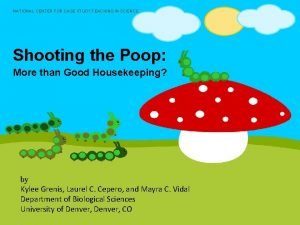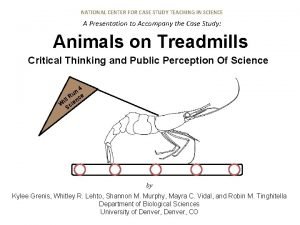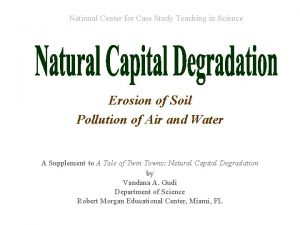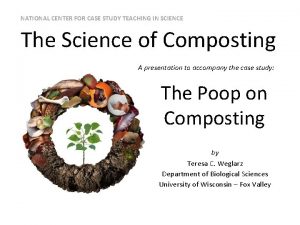NATIONAL CENTER FOR CASE STUDY TEACHING IN SCIENCE









































- Slides: 41

NATIONAL CENTER FOR CASE STUDY TEACHING IN SCIENCE Plant Transpiration: A Story of Clean Air by Sandra J. Connelly Thomas H. Gosnell School of Life Sciences Rochester Institute of Technology, Rochester, NY

Plants Indoors – Let’s Discuss! They are pretty … but do they serve a purpose? 2

In your group, discuss … 1. What is plant transpiration? 2. Why do plants transpire? What is exchanged with the environment? 3. What might affect the transpiration rate of plants? 4. Why would different plants potentially have different transpiration rates? 5. Could you design an experiment to test any of the above? 3

Plant Transpiration The facts! Plants transpire through stomata Exchange CO 2 and O 2 4

Plant Transpiration The facts! Plants depend on transpiration for the movement of water from roots to leaves 5

How do we know? 6

Plant Transpiration The facts! Plants transpire through stomata Exchange CO 2 and O 2 – But what can they lose? 7

How do we know? 8

Applying Transpiration Plant leaves can “inhale” aerosols and destroy the chemicals (“metabolic breakdown”) Proven by radioactively labeled (C 14) formaldehyde (Doman and Romanova, 1962) 9

Applying Transpiration How does transpiration in plants help them break down toxins in the air? WHAT is the link to transpiration? HOW could we test this? 10

Experimenting with Transpiration Day 1 Set up experiment to measure transpiration rates in plants OR run a simulation. Day 2 Estimate your transpiration in g H 2 O / (dm 2 * hr). Correlate your results to uptake of chemical vapors. Determine the potential of plants to “clean” a room. 11

Day 1 Experimental Setup 12

Experimental Setup Set up your experiment –Take VERY careful notes! 13

Experimental Setup: Day 1 Within your group: Obtain a tube and write your name on it. Measure fixed volume of water in centrifuge tube (water fountain or bathroom!) Add food coloring to your water (~5 drops / 25 m. L) Choose your plant / vegetable. Measure and record everything that you can think of! Surface area of leaves/petals, stems, volume water, etc. 14

15

Experimental Setup: Day 1 Within your group: Cover the top of your tube with parafilm. “Seal” your plant – but the top should stick out! Return your experimental tube to your instructor. 16

Experimental Setup: Day 1 • Seal around the top to minimize evaporation from the tube. • Make sure your plant can breathe! 17

Experimental Hypothesis In your group, write a working hypothesis based on your plant in your experiment and your knowledge of transpiration. Keep track of this for Day 2! Do you have all of the notes that you are going to need to calculate transpiration rates and apply your data on Day 2? 18

Day 1 Simulation 19

Transpiration Simulation Run simulation: Virtual Lab: Plant transpiration Work with at least four plants and use the fan, heater, or both! Take notes of your results and email your results to your group members and/or your instructor! 20

Day 2 Data & Application 21

Transpiration Discussion What did you do on Day 1? You set up your experiment to measure transpiration rates in your selected plants Where have your plants been? What have your plants done? 22

Transpiration Rates Using data from your experimental set up … Your plants have transpired since Day 1 – don’t forget to calculate rate per hour! What is your plants surface area (in dm 2)? How much does water weigh? Estimate transpiration rate as ______ g H 2 O / (dm 2 * hr) 23

Simulation Discussion What did you do on Day 1? Ran a simulation of plant transpiration Did transpiration rates differ? WHY? What had the most significant effect on plant transpiration in the simulation? 24

Transpiration Rates Using data from the simulation … Pick one plant from the simulation. Assume a plant surface area of 100 dm 2 for your calculations. How much does water weigh? Estimate transpiration rate as ______ g H 2 O / (dm 2 * hr) 25

Consider the following … 26

Applying Your Results Do you remember how the movement of water and the movement of CO 2 / O 2 is related? 27

Applying Your Results How much CO 2 could your plant take up? At 20°C, transpiration of water causes the uptake of organic vapors at a rate of 1. 8 g H 2 O / (dm 2 * hr) = 16. 8 mg CO 2 / (dm 2 * hr) 28

Let’s think … PROBLEM You want to “green” your commute to school in your “fuel efficient” vehicle! KNOWN Avg CO 2 per 1 gallon of gas = 8, 887 grams QUESTION How many hours would it take your experimental plant to “clean up” after your car? 29 ** http: //www. epa. gov/otaq/climate/documents/420 f 11041. pdf

Let’s think … What do you need to answer this question? Work in your group to “clean up” at least one of your commutes. Your answer should be in plant hours. Hint: How long does your plant have to transpire to take up your car’s carbon emissions? 30

31 http: //www. epa. gov/otaq/climate/documents/420 f 11041. pdf

Consider the following … 32

Plants Indoors They are pretty … but do they serve a purpose? 33

Applying Your Results Do you remember how the movement of water and the movement of CO 2 / O 2 is related? How could this idea be applied to other aerosols / vapors in a room? Consider: Is the air actually “dirty” and can plants remove that “dirt”? 34

Well. . how dirty is the air? 35

How efficient are plants? 36

Let’s think … PROBLEM You manage a building with dirty air! KNOWN 100 ft 2 space with 8 ft ceiling = 800 ft 3 of air needs to be cleaned!! = ______ liters? QUESTION How many plants do you need to “clean” your space in a 24 hour period (constantly)? 37

Data Table 38

Time to exhale … 39

Image Credits Slide 4, 5, 7 Stomata Image: https: //flic. kr/p/s 9 TQdk, , flickr account: microbiologybytes, CC BY-SA 2. 0. Slide 4, 5, 7 Leaf: https: //flic. kr/p/6 y 9 kcg, , flickr account: Andreas Levers, CC BY-NC 2. 0. Slide 6 Transpiration Overview. svg: https: //en. wikipedia. org/wiki/Transpiration#/media/File: Transpiration_Overview. svg, , CC BYSA 3. 0 Uploaded by Laurel Jules Created: May 26, 2013) Slide 8 Transpiration Water Drop; Photo by: Sandi Connelly (sjcsbi@rit. edu) Slide 13, 15 Celery: https: //flic. kr/p/6 UFR 7, flickr account: Dave Morris, CC BY-NC-SA 2. 0. Slide 13 Falcon tube 50 ml 2. jpg; https: //commons. wikimedia. org/wiki/File: Falcon_tube_50 ml_2. jpg (CC BY-SA 3. 0) 22 January 2011 Nadina Wiórkiewicz Slide 13, 15 White flower: https: //flic. kr/p/FNYZT, , flickr account: Balaji Photography, CC BY 2. 0. Slide 15 File: Inscribed cone sphere cylinder. svg A cone, sphere and cylinder of radius r and height h. https: //commons. wikimedia. org/wiki/File: Inscribed_cone_sphere_cylinder. svg#/media/File: Inscribed_cone_sphere_cylin der. svg (CC BY-SA 3. 0) Uploaded by Cmglee Uploaded: April 22, 2011 40

Image Credits Slide 17 Transpiration Flower Setup; Photo by: Sandi Connelly (sjcbi@rit. edu) Slide 26 Image credit: Transpiration Flower Setup 2; Photo by: Sandi Connelly (sjcbi@rit. edu) Slide 29, 30 Green cars https: //flic. kr/p/6 TMy. Jq, Flickr account: Michael Caven, CC BY 2. 0. Slide 32 Plants. https: //flic. kr/p/cu 57 w. U, flickr account: Ann Lusch, CC BY-NC-SA 2. 0. Slide 37 Image: Austin, Texas https: //flic. kr/p/ic. Bi. Yj, Flickr account: Jim Allen Slide 37 Emergency Entrance https: //flic. kr/p/N 7 HHY, Flickr account: Taber Andrew Bain, CC BY 2. 0. Slide 39 Image: meditation spot https: //flic. kr/p/5 n. EKbe, Flickr account: MTSOfan CC BY-NC-SA 2. 0. 41
 National centre for case study teaching in science
National centre for case study teaching in science National center for case study teaching in science
National center for case study teaching in science National center for case study teaching in science
National center for case study teaching in science National center for case study teaching in science answers
National center for case study teaching in science answers National center for case study teaching in science
National center for case study teaching in science National center for case study teaching in science
National center for case study teaching in science National center for case study teaching in science
National center for case study teaching in science Best worst and average case
Best worst and average case Fbi virtual case file case study
Fbi virtual case file case study What's your subject
What's your subject Difference between micro teaching and traditional teaching
Difference between micro teaching and traditional teaching Iso 22301 utbildning
Iso 22301 utbildning Novell typiska drag
Novell typiska drag Tack för att ni lyssnade bild
Tack för att ni lyssnade bild Returpilarna
Returpilarna Shingelfrisyren
Shingelfrisyren En lathund för arbete med kontinuitetshantering
En lathund för arbete med kontinuitetshantering Personalliggare bygg undantag
Personalliggare bygg undantag Tidbok för yrkesförare
Tidbok för yrkesförare A gastrica
A gastrica Densitet vatten
Densitet vatten Datorkunskap för nybörjare
Datorkunskap för nybörjare Tack för att ni lyssnade bild
Tack för att ni lyssnade bild Debattartikel struktur
Debattartikel struktur Autokratiskt ledarskap
Autokratiskt ledarskap Nyckelkompetenser för livslångt lärande
Nyckelkompetenser för livslångt lärande Påbyggnader för flakfordon
Påbyggnader för flakfordon Lufttryck formel
Lufttryck formel Svenskt ramverk för digital samverkan
Svenskt ramverk för digital samverkan Bo bergman jag fryser om dina händer
Bo bergman jag fryser om dina händer Presentera för publik crossboss
Presentera för publik crossboss Jiddisch
Jiddisch Kanaans land
Kanaans land Treserva lathund
Treserva lathund Fimbrietratt
Fimbrietratt Claes martinsson
Claes martinsson Centrum för kunskap och säkerhet
Centrum för kunskap och säkerhet Programskede byggprocessen
Programskede byggprocessen Mat för unga idrottare
Mat för unga idrottare Verktyg för automatisering av utbetalningar
Verktyg för automatisering av utbetalningar Rutin för avvikelsehantering
Rutin för avvikelsehantering Smärtskolan kunskap för livet
Smärtskolan kunskap för livet



























































